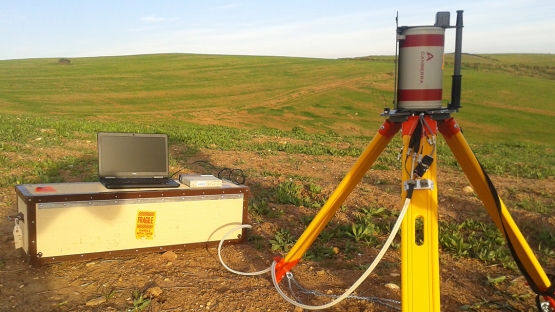Experts in Egypt and Senegal will be better able to fight soil erosion thanks to two gamma spectroscopy detectors which have just been delivered through the IAEA's technical cooperation programme. The detectors will be used for soil erosion assessment in areas that have experienced severe land degradation, a phenomenon that jeopardizes agriculture in many regions of the world, including in arid and semi-arid lands in Africa.
Egypt and Senegal are both suffering from severe land degradation, with soil productivity in most of the northeast Nile Delta in Egypt, for instance, having decreased by more than 45% in the last 35 years according to recent studies. Land degradation is the result of several factors, including overexploitation of land, unsustainable agricultural practices and extreme weather events – which have occurred more frequently in the last few decades. Soil erosion, a major type of land degradation caused by both human and environmental factors, can lead to the complete loss of the fertile topsoil, leaving the affected land unfit for agriculture.
Agriculture is an important economic sector in most African countries (accounting for approximately 12% of Egypt's GDP and 17% of Senegal's), and low-input farming from subsistence farms run by families represents a significant component of this sector. It accounts for a high proportion of jobs, and provides livelihoods to subsistence farmers and their families. As this type of farming typically takes place on arid and semiarid land with marginal agricultural potential, such as drylands and mountains, it is particularly susceptible to soil erosion.
The IAEA, in cooperation with the Food and Agriculture Organization of the United Nations (FAO), has been assisting countries for more than 20 years in combating land degradation by supporting the utilization of isotopic techniques to assess soil erosion.
Fallout radionuclide tracers, such as caesium-137 (Cs-137), have been used extensively in assessing soil erosion and sedimentation. This radionuclide is present in the atmosphere, from where it falls to the ground in precipitation and accumulates in the uppermost soil layer. During erosion, the topsoil is washed away, which can be measured as decreased levels of Cs-137. At the same time, where the eroded soil settles, increased levels of Cs-137 are seen.
The erosion assessment using Cs-137 has many advantages compared to traditional methods, said Emil Fulajtar, a soil scientist in the Joint FAO/IAEA Division of Nuclear Techniques in Food and Agriculture. This method provides long term mean erosion rates while conventional methods provide mostly short-term data. Using this technique, there is therefore no need for long and resource-demanding monitoring programmes: soil redistribution can be assessed in a single sampling campaign. It also helps determine the spatial distribution of erosion, essential input for soil conservation programmes aimed at sustainable land management and thereby food security.
The provision of gamma spectrometers, which are used to carry out the Cs-137 measurements, is part of an ongoing initiative by the Joint FAO/IAEA Division to help African countries enhance their capacity to control soil erosion; this also includes the training of scientists on the use of the Cs-137 method and the establishment of gamma spectroscopy capacities across the continent. Another three tabletop gamma detectors (for Madagascar, Algeria and Zimbabwe) and three portable gamma detectors (for Morocco, Tunisia and Madagascar) have already been delivered.
"We will use the gamma detectors for the 'fingerprinting' of sedimentation in the Nile River to trace the origin of contamination from different sources, such as drainage from industrial and agricultural bodies located on the riverbank," said Mohamed Kassab, a lecturer at the Egyptian Atomic Energy Authority's Nuclear Research Centre. "We also plan to help other countries in Africa to build capacity in gamma measurements and analytical services."
How nuclear science and technology help us improve agriculture will be a topic discussed at the IAEA Ministerial Conference on Nuclear Science and Technology. Watch the event live on 28-30 November 2018. Have a look at the full programme here.





